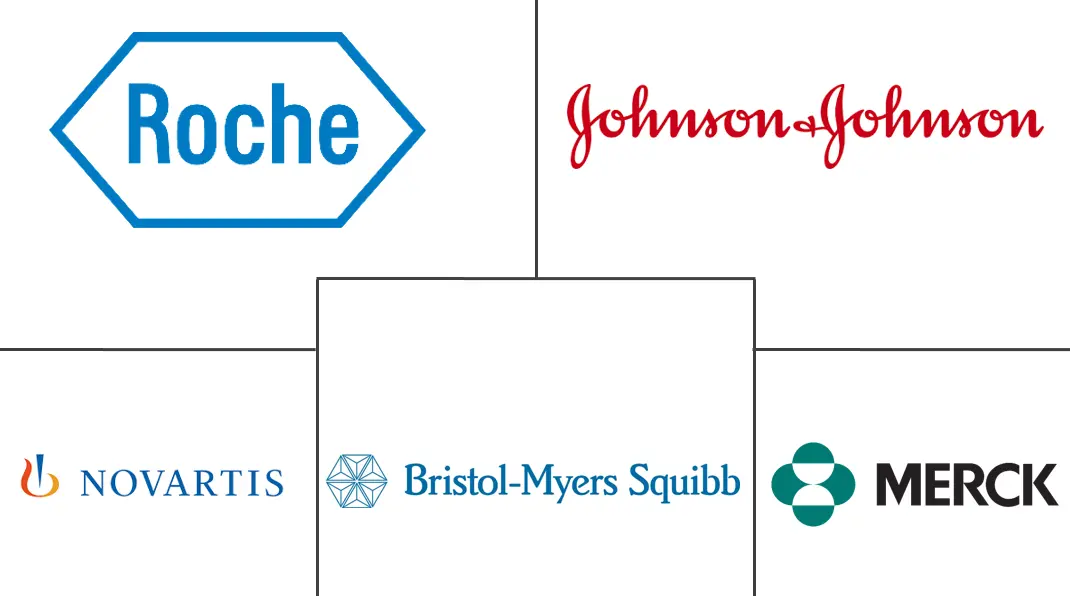Global T-Cell Lymphoma Market Size and Share
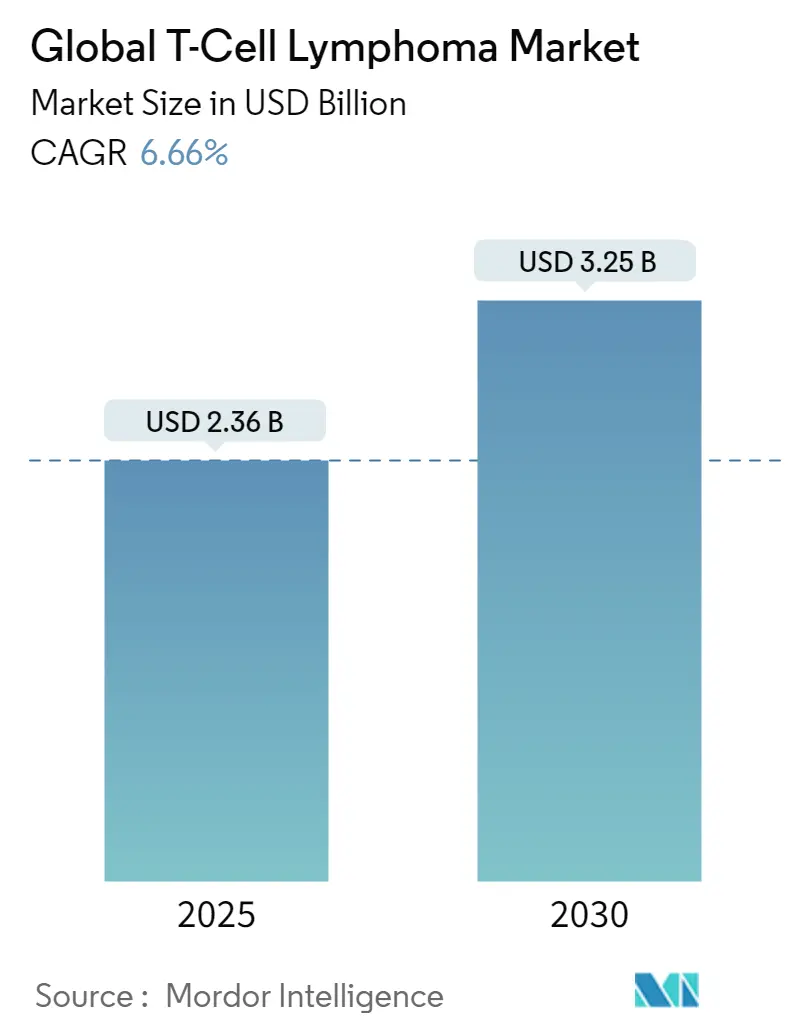
Global T-Cell Lymphoma Market Analysis by Mordor Intelligence
The Global T-Cell Lymphoma Market size is estimated at USD 2.36 billion in 2025, and is expected to reach USD 3.25 billion by 2030, at a CAGR of 6.66% during the forecast period (2025-2030).
Due to the high transmission rate of COVID-19 and lack of treatment, many countries suffered and continue to bear a significant burden on their economies and healthcare systems. The COVID-19 outbreak may put patients with Cutaneous T-Cell Lymphoma at additional risk of not receiving the necessary diagnostic procedures and treatment because they cannot access hospitals easily or due to healthcare resources limitations. Several guidelines for managing Cutaneous T-Cell Lymphoma have been recently published to help dermatologists choose the right approach in the COVID-19 pandemic. However, these guidelines happen to be not applicable in countries that are still under lockdown or do not have enough resources to implement the plan.
Moreover, the outbreak of COVID-19 impacted the T-Cell Lymphoma Market, as hospitals and healthcare services were significantly reduced due to social distancing measures enforced globally. The COVID-19 pandemic also affected the global economy and showed a huge impact on the general hospital care functioning for non-COVID-19 patients in hospitals across the world.
The growth of the T-Cell Lymphoma Market is attributed to the rise in lymphoma cancer incidence due to radiation, an increase in the number of T-Cell lymphoma-specific therapies, and the risk of lymphoma due to autoimmune disorders.
According to the Leukemia & Lymphoma Society 2021, 186,400 people in the United States were diagnosed with leukemia and lymphoma in 2021. In addition, 825,651 people lived with lymphoma in the United States, 152,671 people lived with Hodgkin lymphoma, and 672,980 people lived with non-Hodgkin lymphoma. T-Cell Lymphoma significantly contributes to non-Hodgkin lymphoma, which further boosts the overall market growth.
In addition, the growing uptake of premium-priced products such as Keytruda, Opdivo, and immune checkpoint inhibitors in the Cancer Immunotherapy Market, and the launch of several novel therapies with label extension of commercialized products, are also boosting the overall market growth. However, the high cost associated with Lymphoma Treatment and the adverse side effects of therapies have been obstructing the overall market growth.
Global T-Cell Lymphoma Market Trends and Insights
Chemotherapy is Expected to Hold Significant Market Share over the Forecast Period
Chemotherapy is a type of drug treatment often used in the Lymphoma Treatment. It works by stopping and slowing down the growth of cancer cells. Surgery and radiation therapy work by removing, killing, or damaging the cancer cells in a particular area, but chemotherapy works throughout the whole body. This means that chemotherapy can destroy and damage cancer cells that have spread to other parts of the body away from the original tumor.
According to the European Society for Medical Oncology, the COVID-pandemic had generated a huge backlog in oncology care and research. In addition, Cancer Treatment was hit by the COVID-19 pandemic due to the halt in diagnostic procedures and surgical procedures. Moreover, as per many studies, cancer patients are more susceptible to coronavirus than individuals without cancer, as they are in an immunosuppressive state caused by the malignancy and anticancer treatment.
For instance, as per the American Society of Clinical Oncology, chemotherapy treatments and follow-ups were postponed during the COVID-19 pandemic. Even private clinics in major Indian cities reported a nearly 50% decrease in patients for Cancer Care. Overall cancer services declined by 50% in April and May 2020. As per a study titled 'Impact of nationwide lockdown on cancer care during COVID-19 pandemic: A retrospective analysis from western India' published in 2021, chemotherapy was the most commonly received treatment (before lockdown 71.8% and during lockdown 45.9%).
Chemotherapy is used with surgery or radiation therapy, or both. In some cases, it is used in combination with other drugs, such as hormone therapy, Targeted Therapy, or immunotherapy. For example, chemo may be used to shrink a tumor before surgery or radiation therapy. Chemo used in this way is called neoadjuvant therapy or after surgery or radiation therapy to help kill any remaining cancer cells in the body. Chemo used in this way is called adjuvant therapy.
There are several types of chemotherapies given to T-Cell Lymphoma patients, including alkylating agents, plant alkaloids, antitumor antibiotics, antimetabolites, topoisomerase inhibitors, and miscellaneous antineoplastics.
Favorable reimbursement policies concerning these drugs, making them accessible and affordable, are expected to positively impact the market studied. For instance, Pralatrexate, a chemotherapy drug used to treat patients with relapsed/refractory Peripheral T-Cell Lymphoma (PTCL), is listed under the PBS scheme by the Australian government.
Thus, with the rising awareness about the benefits of chemotherapy and favorable government policies, the market studied is expected to flourish during the forecast period.
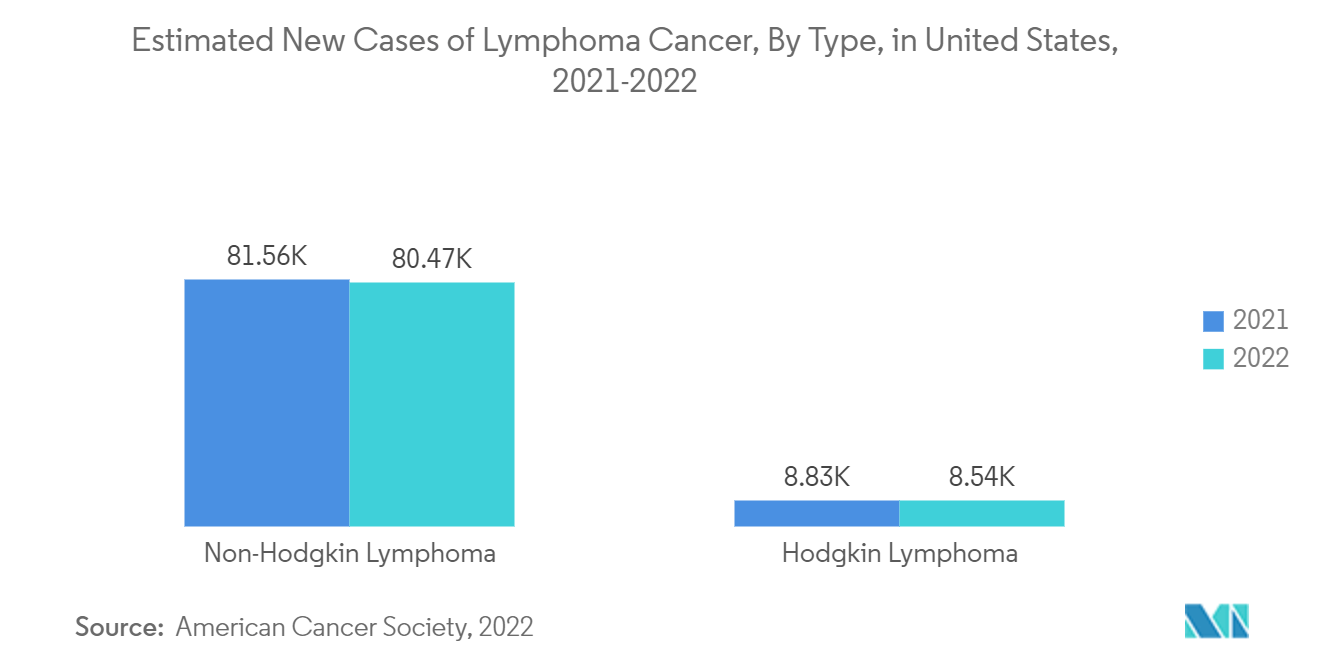
North America Dominates the Market, and it is Expected to do the Same over the Forecast Period
Some of the factors driving market growth in the North American region include the high prevalence of T-Cell Lymphoma, the presence of key market players, and increasing research and development activities.
The COVID-19 outbreak impacted the cancer T-Cell Lymphoma Market, as hospitals and healthcare services were significantly reduced due to social distancing measures enforced in the North American region. Some biopharmaceutical companies, such as Merck & Co. Inc. and Eli Lilly and Company, announced clinical trial delays. For instance, the data from ClinicalTrials.gov showed that more than 200 interventional oncology studies were suspended in March and April 2020 as a result of the COVID-19 crisis. In addition, 60% of institutions in the United States are enrolling new patients at a lower rate.
According to the Globocan 2020 report, Canada had 8,506 cases of Non-Hodgkin Lymphoma and 313 deaths caused due to it in 2020. This is expected to increase T-Cell Lymphoma incidence in the country. The increase in cases of Non-Hodgkin Lymphoma is expected to boost the demand for treatment options, which is going to positively aid market development, as T-Cell lymphomas are a type of Non-Hodgkin Lymphoma.
Some of the major companies that operate in the oncology segment in the North American region are adopting several strategies, such as collaboration and acquisition, to strengthen their positions in the T-Cell Lymphoma Market. For instance, in August 2020, BostonGene Corporation announced the collaboration with The Weinstock Laboratory, which is at Dana-Farber Cancer Institute Inc. The collaboration is focused on defining predictors of response to PI3 kinase inhibition in relapsed/refractory T-Cell Lymphomas. In addition, other companies, such as Amgen and Merck, have been working on developing Cancer Therapies for T-Cell Lymphomas. Hence, the aforementioned factors are expected to fuel market growth in this region.
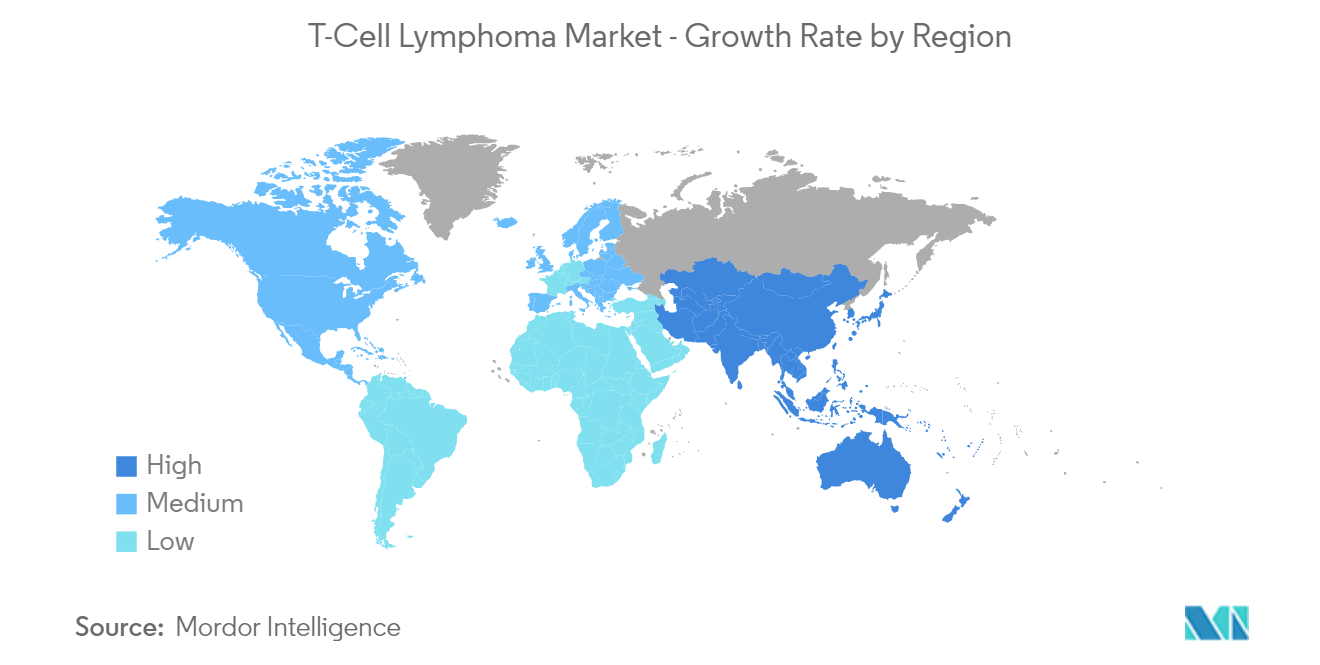
Competitive Landscape
The T-Cell Lymphoma Market is highly competitive and consists of a few major players. Companies like Johnson & Johnson (Janssen Pharmaceuticals Inc.), Novartis AG, Bristol Myers Squibb Company, Merck & Co. Inc., and F. Hoffmann-La Roche Ltd hold a substantial share in the market.
Global T-Cell Lymphoma Industry Leaders
-
Johnson & Johnson (Janssen Pharmaceuticals Inc.)
-
Novartis AG
-
Bristol Myers Squibb Company
-
Merck & Co. Inc
-
F. Hoffmann-La Roche Ltd
- *Disclaimer: Major Players sorted in no particular order
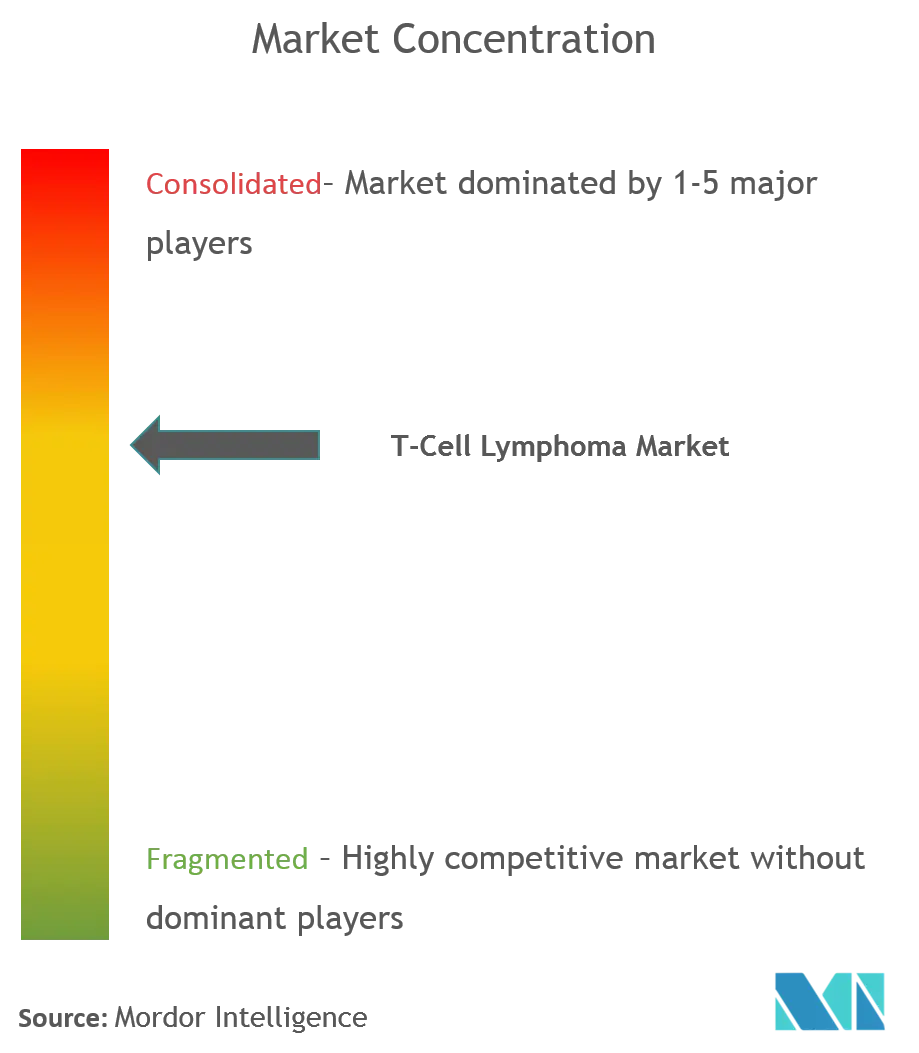
Recent Industry Developments
In September 2021, Soligenix Inc. announced that the US Food and Drug Administration's (FDA) Office of Orphan Products Development granted orphan drug designation to the active ingredient hypericin for the treatment of T-cell lymphoma, expanding the target population beyond the previously granted cutaneous T-cell lymphoma (CTCL).
In December 2020, the FDA cleared an investigational new drug application for LB1901, a chimeric antigen receptor T-cell therapy in development for the treatment of adults with relapsed or refractory T-cell lymphoma, according to the agent's manufacturer.
In July 2020, miRagen Therapeutics Inc. announced that the Food and Drug Administration (FDA) had granted orphan drug designation to cobomarsen for the treatment of T-cell lymphoma. Cobomarsen is an inhibitor and is being developed by miRagen in two clinical programs to address different types of T-cell lymphomas, which include a Phase 2 trial for cutaneous T-cell lymphoma (CTCL) and a Phase 1 trial for adult T-cell lymphoma (ATLL).
Global T-Cell Lymphoma Market Report Scope
As per the scope of the report, lymphoma occurs when a lymphocyte, a type of white blood cell, is out of control inside the body, affecting the body's immune capacity to fight against infection. Lymphomas are grouped as Hodgkin (abnormal B-cells) and non-Hodgkin (developing from abnormal T-cells or B-cells) lymphomas. The T-cell lymphoma market is segmented by type of lymphoma (peripheral T-cell lymphoma, cutaneous T-cell Lymphoma, anaplastic large cell lymphoma, angio-immuno-blastic T-cell lymphoma, other types of lymphoma), T-cell lymphoblastic lymphoma), type of therapy (radiotherapy, chemotherapy, immunotherapy, stem cell transplantation, other types of therapies) and geography (North America, Europe, Asia-Pacific, Middle East & Africa, and South America). The market report also covers the estimated market sizes and trends for 17 different countries across major regions globally. The report offers the value (in USD million) for the above segments.
| Peripheral T-cell Lymphoma | Cutaneous T-cell Lymphoma |
| Anaplastic Large Cell Lymphoma | |
| Angio-immuno-blastic T-cell Lymphoma | |
| Other Types of Lymphoma | |
| T-cell Lymphoblastic Lymphoma |
| Radiotherapy |
| Chemotherapy |
| Immunotherapy |
| Stem Cell Transplantation |
| Other Types of Therapies |
| North America | United States |
| Canada | |
| Mexico | |
| Europe | Germany |
| United Kingdom | |
| France | |
| Italy | |
| Spain | |
| Rest of Europe | |
| Asia-Pacific | China |
| Japan | |
| India | |
| Australia | |
| South Korea | |
| Rest of Asia-Pacific | |
| Middle East & Africa | GCC |
| South Africa | |
| Rest of Middle East & Africa | |
| South America | Brazil |
| Argentina | |
| Rest of South America |
| By Type of Lymphoma | Peripheral T-cell Lymphoma | Cutaneous T-cell Lymphoma |
| Anaplastic Large Cell Lymphoma | ||
| Angio-immuno-blastic T-cell Lymphoma | ||
| Other Types of Lymphoma | ||
| T-cell Lymphoblastic Lymphoma | ||
| By Type of Therapy | Radiotherapy | |
| Chemotherapy | ||
| Immunotherapy | ||
| Stem Cell Transplantation | ||
| Other Types of Therapies | ||
| Geography | North America | United States |
| Canada | ||
| Mexico | ||
| Europe | Germany | |
| United Kingdom | ||
| France | ||
| Italy | ||
| Spain | ||
| Rest of Europe | ||
| Asia-Pacific | China | |
| Japan | ||
| India | ||
| Australia | ||
| South Korea | ||
| Rest of Asia-Pacific | ||
| Middle East & Africa | GCC | |
| South Africa | ||
| Rest of Middle East & Africa | ||
| South America | Brazil | |
| Argentina | ||
| Rest of South America | ||
Key Questions Answered in the Report
How big is the Global T-Cell Lymphoma Market?
The Global T-Cell Lymphoma Market size is expected to reach USD 2.36 billion in 2025 and grow at a CAGR of 6.66% to reach USD 3.25 billion by 2030.
What is the current Global T-Cell Lymphoma Market size?
In 2025, the Global T-Cell Lymphoma Market size is expected to reach USD 2.36 billion.
Who are the key players in Global T-Cell Lymphoma Market?
Johnson & Johnson (Janssen Pharmaceuticals Inc.), Novartis AG, Bristol Myers Squibb Company, Merck & Co. Inc and F. Hoffmann-La Roche Ltd are the major companies operating in the Global T-Cell Lymphoma Market.
Which is the fastest growing region in Global T-Cell Lymphoma Market?
Asia Pacific is estimated to grow at the highest CAGR over the forecast period (2025-2030).
Which region has the biggest share in Global T-Cell Lymphoma Market?
In 2025, the North America accounts for the largest market share in Global T-Cell Lymphoma Market.
What years does this Global T-Cell Lymphoma Market cover, and what was the market size in 2024?
In 2024, the Global T-Cell Lymphoma Market size was estimated at USD 2.20 billion. The report covers the Global T-Cell Lymphoma Market historical market size for years: 2019, 2020, 2021, 2022, 2023 and 2024. The report also forecasts the Global T-Cell Lymphoma Market size for years: 2025, 2026, 2027, 2028, 2029 and 2030.
Page last updated on:
Global T-Cell Lymphoma Market Report
The T-Cell Lymphoma market report provides a comprehensive industry overview, highlighting key market trends and growth patterns. The report is segmented by various types of lymphoma, including Peripheral T-cell Lymphoma, Cutaneous T-cell Lymphoma, Anaplastic Large Cell Lymphoma, and Angio-immuno-blastic T-cell Lymphoma, among others. It also covers different types of therapies such as Radiotherapy, Chemotherapy, Immunotherapy, and Stem Cell Transplantation.
The industry analysis includes market segmentation by geography, covering North America, Europe, Asia-Pacific, Middle East & Africa, and South America. Detailed market data and market value are provided to give a clear picture of the market size and market growth. The market forecast offers insights into future market outlook and market predictions.
The report also discusses market leaders and their influence on the market trends. Industry statistics and industry research are included to support the market review and industry sales analysis. The market report is a valuable resource for understanding the market segmentation and market overview.
Additionally, the report includes a market forecast and market predictions to help stakeholders make informed decisions. Industry reports and industry research provide in-depth knowledge of the market, while the market review offers a summary of key findings. The report pdf is available for those who want to delve deeper into the industry information and industry outlook.
Overall, this report serves as an essential guide for anyone looking to understand the T-Cell Lymphoma market, its current state, and future prospects.
